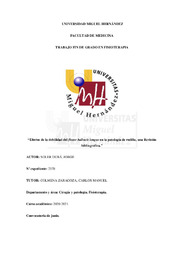Resumen :
Introducción: El pie es una estructura fundamental en la estabilidad. El arco plantar y el ángulo
Q son factores de riesgo en lesiones de rodilla en mujeres, pudiendo afectar a la biomecánica de
la marcha. El papel del flexor hallucis longus (FHL) en las disfunciones biomecánicas y en las
lesiones del miembro inferior se perfila como capital.
Objetivos: Observar la relación del FHL respecto a la patología de rodilla, junto con el examen
en los cambios biomecánicos de la marcha, la posible ganancia de fuerza en el FHL con la mejora
del ángulo Q y la estabilidad y el gasto energético relacionado con este.
Material y métodos: Se realizó una revisión sistemática analizando 6 bases de datos, encontrando
76 artículos de los cuales se seleccionaron 28, evaluados posteriormente con la Escala PEDro.
Resultados: Se encontraron diferencias significativas entre géneros en la deformación del arco
plantar longitudinal medial (APLM). La activación del FHL es mayor cuando se aumenta la
velocidad de la marcha. Existe relación entre el valgo dinámico y la lesión del ligamento cruzado
anterior (LCA), ángulo que en apariencia se puede modificar.
Discusión: Una variación en el recorrido del tendón del FHL podría conllevar cambios
biomecánicos y déficits en la contracción; además de alteraciones en la marcha, así como un
aumento del ángulo Q, que también podría producir lesiones de rodilla. No obstante, este se podría
disminuir mediante un programa de ejercicios, lo que también conllevaría a un menor gasto
energético.
Conclusiones: La debilidad del FHL puede causar modificaciones en la estructura, en el gasto
energético y en la biomecánica de la marcha, al igual que un aumento del ángulo Q. Ambas
alteraciones pueden mejorarse mediante ejercicio activo.
Introduction: The foot is an essential structure for stability. The plantar arch and the Q-angle are
risk factors for knee injuries among women and it may affect gait biomechanics. The role of the
flexor hallucis longus (FHL) is considered as crucial in biomechanical dysfunctions and lower
limb injuries.
Objectives: The aim is to observe the link between the FHL and the knee pathology, the
biomechanical changes in gait, the potential strength gain in the FHL by an improvement of the
Q-angle and stability, and the energy waste related to the Q-angle.
Data and methods: A systematic review of 6 databases was carried out. 76 papers were found,
from which 28 were selected and later evaluated in PEDro scale.
Results: Significant differences between genders were found in the deformation of the medial
longitudinal plantar arch (MLA). The activation of the FHL is greater when the gait speed is
increased. There is a connection between the dynamic valgus and the anterior cruciate ligament
(ACL) injury, an angle that can be modified.
Discussion: A variation in the travel of the FHL’s tendon could lead to biomechanical changes
and deficit in contraction. It could also lead to gait alterations or to an increase of the Q-angle that
could cause knee injuries. Nevertheless, the Q-angle could be decreased through a programmed
sequence of set exercises which would also lead to lower energy waste.
Conclusions: A FHL deficiency may cause changes in structure, energy waste and gait
biomechanics, as well as an increase of the Q-angle. Both alterations can be improved
through active exercise.
Key words: flexor hallucis longus, knee injury, dynamic valgus, Q-angle, active exercise.
|
 La licencia se describe como: Atribución-NonComercial-NoDerivada 4.0 Internacional.
La licencia se describe como: Atribución-NonComercial-NoDerivada 4.0 Internacional.
.png)
